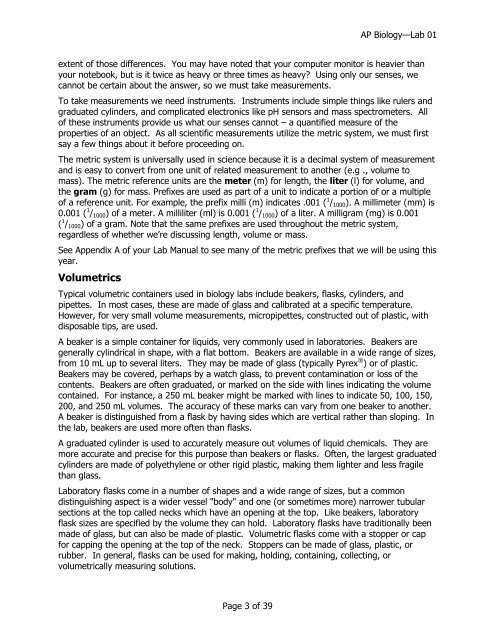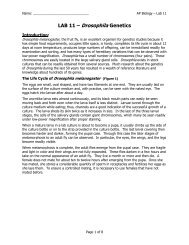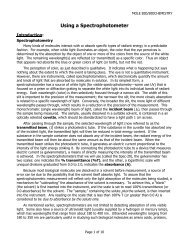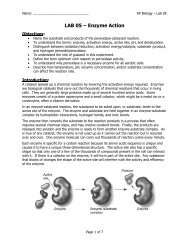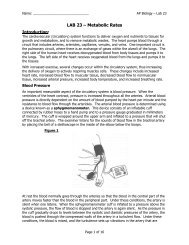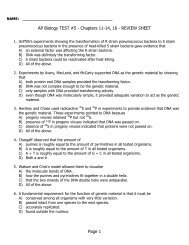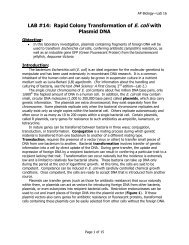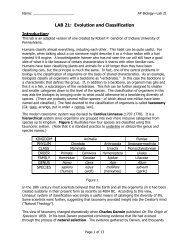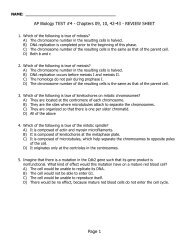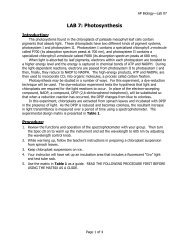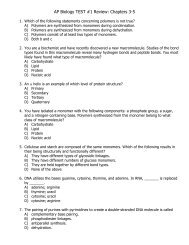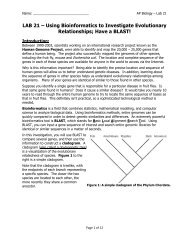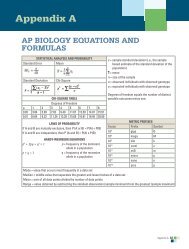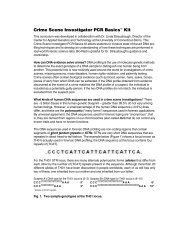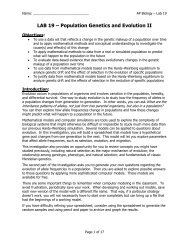LAB 1 â Biology Lab Skills
LAB 1 â Biology Lab Skills
LAB 1 â Biology Lab Skills
Create successful ePaper yourself
Turn your PDF publications into a flip-book with our unique Google optimized e-Paper software.
AP <strong>Biology</strong>—<strong>Lab</strong> 01<br />
extent of those differences. You may have noted that your computer monitor is heavier than<br />
your notebook, but is it twice as heavy or three times as heavy? Using only our senses, we<br />
cannot be certain about the answer, so we must take measurements.<br />
To take measurements we need instruments. Instruments include simple things like rulers and<br />
graduated cylinders, and complicated electronics like pH sensors and mass spectrometers. All<br />
of these instruments provide us what our senses cannot – a quantified measure of the<br />
properties of an object. As all scientific measurements utilize the metric system, we must first<br />
say a few things about it before proceeding on.<br />
The metric system is universally used in science because it is a decimal system of measurement<br />
and is easy to convert from one unit of related measurement to another (e.g ., volume to<br />
mass). The metric reference units are the meter (m) for length, the liter (l) for volume, and<br />
the gram (g) for mass. Prefixes are used as part of a unit to indicate a portion of or a multiple<br />
of a reference unit. For example, the prefix milli (m) indicates .001 ( 1 / 1000 ). A millimeter (mm) is<br />
0.001 ( 1 / 1000 ) of a meter. A milliliter (ml) is 0.001 ( 1 / 1000 ) of a liter. A milligram (mg) is 0.001<br />
( 1 / 1000 ) of a gram. Note that the same prefixes are used throughout the metric system,<br />
regardless of whether we‘re discussing length, volume or mass.<br />
See Appendix A of your <strong>Lab</strong> Manual to see many of the metric prefixes that we will be using this<br />
year.<br />
Volumetrics<br />
Typical volumetric containers used in biology labs include beakers, flasks, cylinders, and<br />
pipettes. In most cases, these are made of glass and calibrated at a specific temperature.<br />
However, for very small volume measurements, micropipettes, constructed out of plastic, with<br />
disposable tips, are used.<br />
A beaker is a simple container for liquids, very commonly used in laboratories. Beakers are<br />
generally cylindrical in shape, with a flat bottom. Beakers are available in a wide range of sizes,<br />
from 10 mL up to several liters. They may be made of glass (typically Pyrex ® ) or of plastic.<br />
Beakers may be covered, perhaps by a watch glass, to prevent contamination or loss of the<br />
contents. Beakers are often graduated, or marked on the side with lines indicating the volume<br />
contained. For instance, a 250 mL beaker might be marked with lines to indicate 50, 100, 150,<br />
200, and 250 mL volumes. The accuracy of these marks can vary from one beaker to another.<br />
A beaker is distinguished from a flask by having sides which are vertical rather than sloping. In<br />
the lab, beakers are used more often than flasks.<br />
A graduated cylinder is used to accurately measure out volumes of liquid chemicals. They are<br />
more accurate and precise for this purpose than beakers or flasks. Often, the largest graduated<br />
cylinders are made of polyethylene or other rigid plastic, making them lighter and less fragile<br />
than glass.<br />
<strong>Lab</strong>oratory flasks come in a number of shapes and a wide range of sizes, but a common<br />
distinguishing aspect is a wider vessel "body" and one (or sometimes more) narrower tubular<br />
sections at the top called necks which have an opening at the top. Like beakers, laboratory<br />
flask sizes are specified by the volume they can hold. <strong>Lab</strong>oratory flasks have traditionally been<br />
made of glass, but can also be made of plastic. Volumetric flasks come with a stopper or cap<br />
for capping the opening at the top of the neck. Stoppers can be made of glass, plastic, or<br />
rubber. In general, flasks can be used for making, holding, containing, collecting, or<br />
volumetrically measuring solutions.<br />
Page 3 of 39


